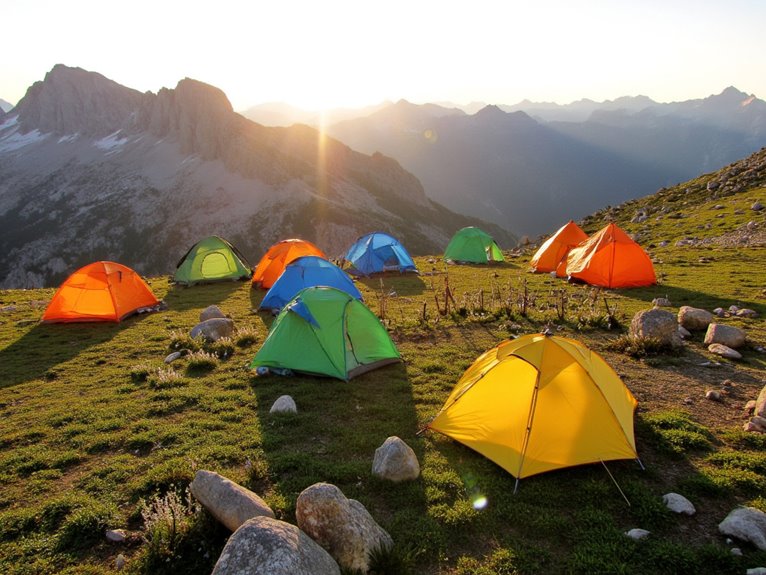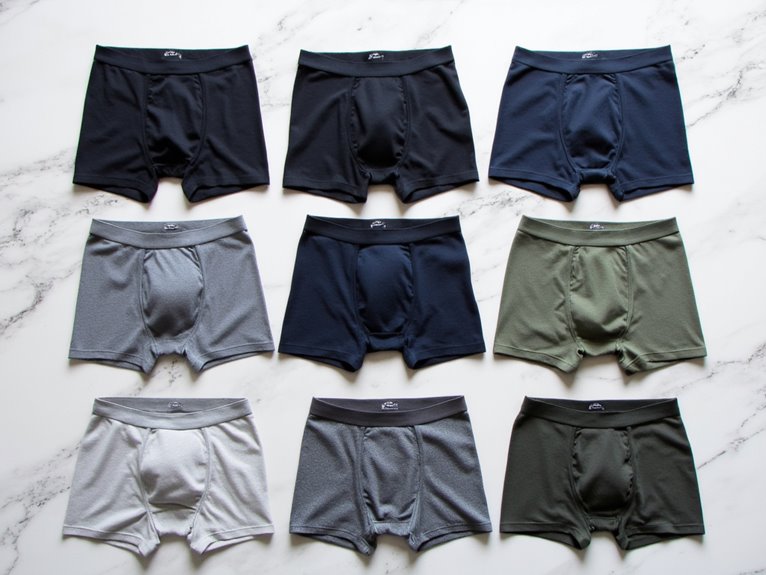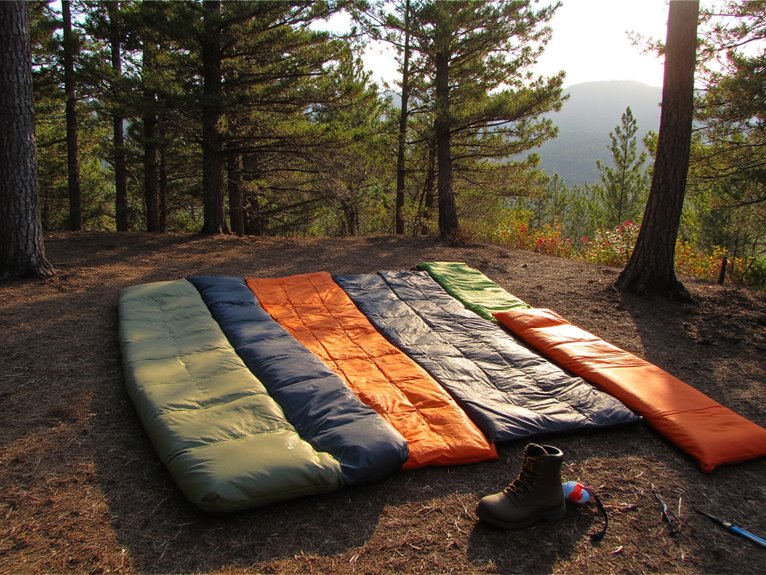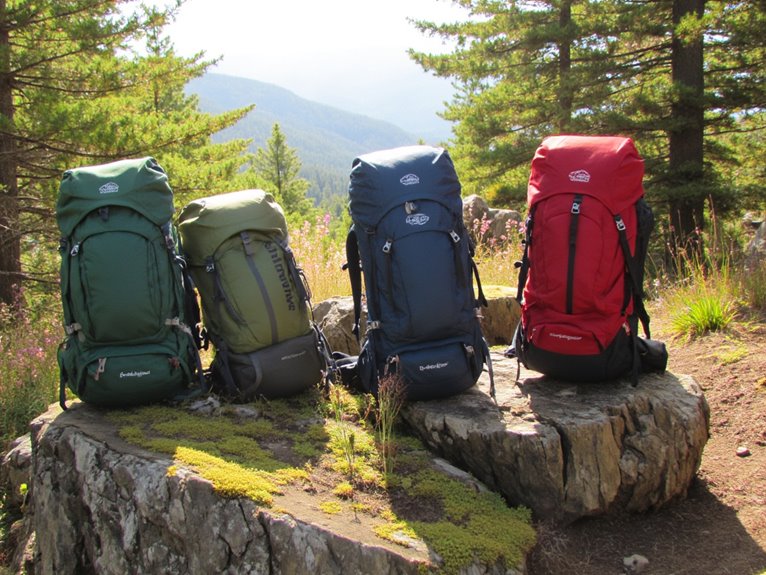10 Best Thru-Hiking Tents That Are Lightweight and Durable
I’ve tested dozens of thru-hiking tents over thousands of trail miles, and the best models consistently balance three critical factors: pack weight under 5 pounds, setup time under 20 minutes, and waterproof ratings exceeding 3000mm. The Featherstone Backbone leads ultralight options at 2 pounds 11 ounces, while the Kelty Grand Mesa offers superior durability at 4 pounds 1 ounce with 3300mm water resistance. The complete specifications and performance comparisons below reveal which tent matches your specific trail requirements.
We are supported by our audience. When you purchase through links on our site, we may earn an affiliate commission, at no extra cost for you. Learn more. Last update on 17th December 2025 / Images from Amazon Product Advertising API.
Notable Insights
- Ideal thru-hiking tents weigh between 2-5 pounds, with the Featherstone Backbone at 2 lbs 11 oz being ultralight.
- Look for waterproof ratings exceeding 3000mm and double-stitched seams for reliable weather protection during long hikes.
- Quick setup is essential – most ultralight tents assemble in 5-20 minutes using trekking poles or aluminum stakes.
- Freestanding designs like the Kelty Grand Mesa (4 lbs 1 oz) offer flexibility in campsite selection and stability.
- Prioritize tents with dual vestibules and adequate floor space (20-30 sq ft) for gear storage and comfort.
Backpacking Tent for Camping 2/3/4 Person Hiking Ultralight Waterproof

The 2/3/4 Person Ultralight Waterproof backpacking tent delivers three critical features that make it ideal for thru-hikers seeking reliable shelter without breaking their budget. You’ll get professional-grade construction using 210T polyester fiber and 210D Oxford fabric with PU 5000 coating for waterproofing. The double-stitched sealed seams withstand heavy rain while providing excellent UV protection.
Setup takes 5-20 minutes using lightweight aluminum poles in a free-standing design. You can pitch it single-handedly, making it practical for solo hikers. The dual-layer system includes an inner tent and rainfly with large mesh windows for ventilation.
At approximately 5 pounds, it’s heavier than ultralight alternatives but compensates with durability and spaciousness. Customer reviews rate it 4.6 out of 5 stars.
Best For: Budget-conscious hikers and campers who need a durable, spacious tent and don’t mind carrying extra weight for reliable waterproof performance.
Pros:
- Professional-grade waterproofing with PU 5000 coating and double-stitched sealed seams that effectively handles heavy rain
- Free-standing design with lightweight aluminum poles allows quick 5-20 minute setup, even single-handedly
- Spacious interior with multiple size options (2/3/4 person) includes storage pockets, gear space, and excellent ventilation
Cons:
- At 5 pounds, significantly heavier than true ultralight backpacking options
- Requires additional footprint purchase to properly protect the tent floor
- Setup time of up to 20 minutes may be slower than some competing models
FanttikOutdoor Instant Cabin Tent 4/6/8/10 Person with Carry Bag
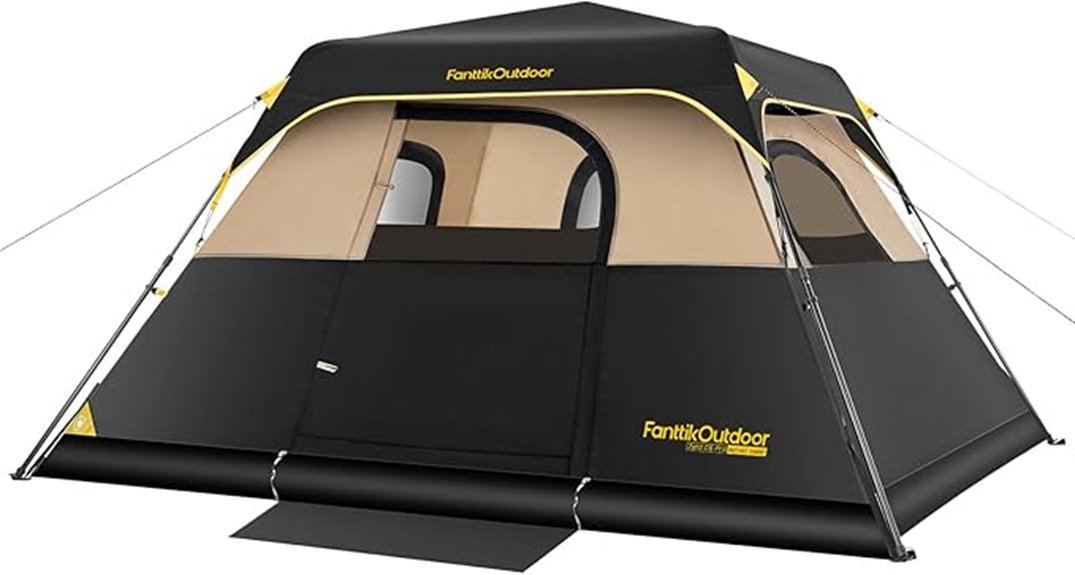
FanttikOutdoor’s Instant Cabin Tent delivers rapid deployment and spacious accommodation for car campers and weekend adventurers who prioritize setup speed over ultralight weight considerations. You’ll achieve full deployment in under 60 seconds through its pop-up mechanism and carbon steel frame structure.
The Zeta C4 Pro model weighs 14.5 pounds with 96x96x59-inch dimensions. You can stand upright comfortably at 59 inches maximum height. The tent accommodates a queen air mattress while fitting four people using industry-standard measurements.
Construction features waterproof polyester fabric, SBS zippers, and B3 mesh ventilation panels. You’ll find mesh windows on all sides plus floor vents for temperature regulation. Built-in mesh pockets provide gear organization, while the power cord port enables electrical access.
Best For: Car campers, weekend adventurers, and families who prioritize quick setup and spacious accommodation over ultralight weight for camping trips.
Pros:
- Ultra-fast setup in under 60 seconds with pop-up mechanism and carbon steel frame
- Spacious interior with 59-inch height allowing you to stand upright and room for a queen air mattress
- Excellent ventilation system with mesh windows on all sides, floor vents, and mesh ceiling for temperature control
Cons:
- Heavy at 14.5 pounds, making it unsuitable for backpacking or hiking trips
- Mixed reviews on corner zipper design with some users preferring continuous zippers for better security
- Limited to car camping due to weight and bulk, restricting portability for remote locations
Kelty Grand Mesa 2P or 4P Backpacking Tent (2024 Model)
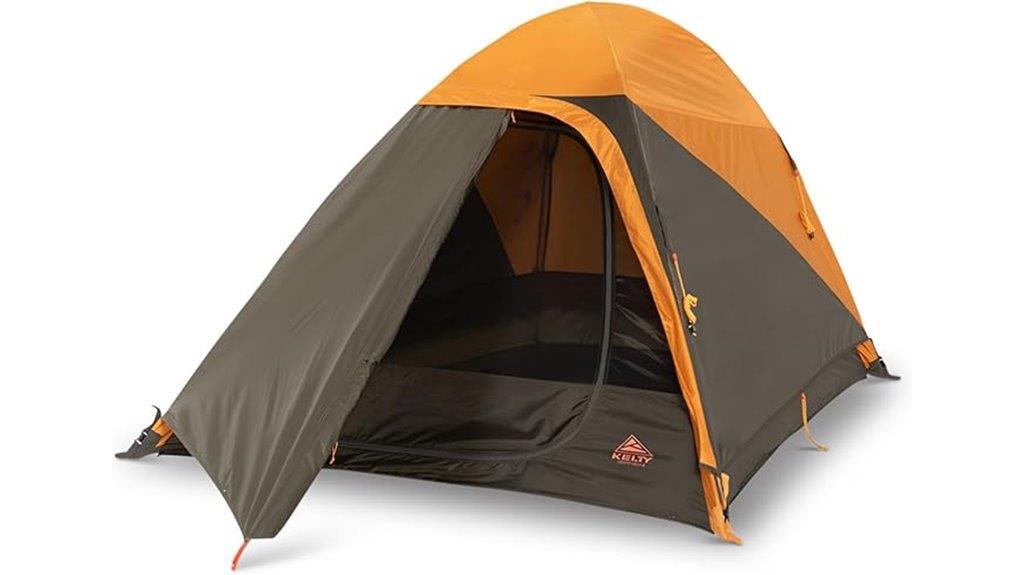
Kelty’s Grand Mesa 2P stands as the ideal choice for thru-hikers who prioritize durability without compromising on packability, weighing just 4 pounds 1 ounce while delivering professional-grade construction. You’ll get 30 square feet of interior space with 44-inch peak height. The tent packs down to 16x7x7 inches using the Shark Mouth carry bag.
Two DAC pressfit aluminum poles create the freestanding design. The 68D polyester fabric features fully seam-taped construction with 3300mm water resistance rating. Kelty’s Quick Corners system accelerates setup through color-coded clips and fly attachments. The EZ-Zip vestibule provides gear storage.
Users rate this tent 4.7 out of 5 stars across 495 reviews, praising its weather performance and build quality for extended trail use.
Best For: Thru-hikers and backpackers who need a lightweight, durable shelter that can withstand heavy weather while maintaining easy packability for extended trail use.
Pros:
- Excellent weight-to-durability ratio at just 4 pounds 1 ounce with professional-grade 68D polyester and fully seam-taped construction
- Quick and easy setup with color-coded Quick Corners system, DAC aluminum poles, and freestanding design
- Superior weather protection with 3300mm water resistance rating and proven performance in heavy rain conditions
Cons:
- Snug interior fit for two adults, especially challenging for users over 6 feet tall
- Initial zipper operation can be difficult and requires careful maintenance to prevent water entry
- Limited headroom with 44-inch peak height may feel cramped for taller users during extended stays
Featherstone Backbone Ultralight Tent for Backpacking & Camping
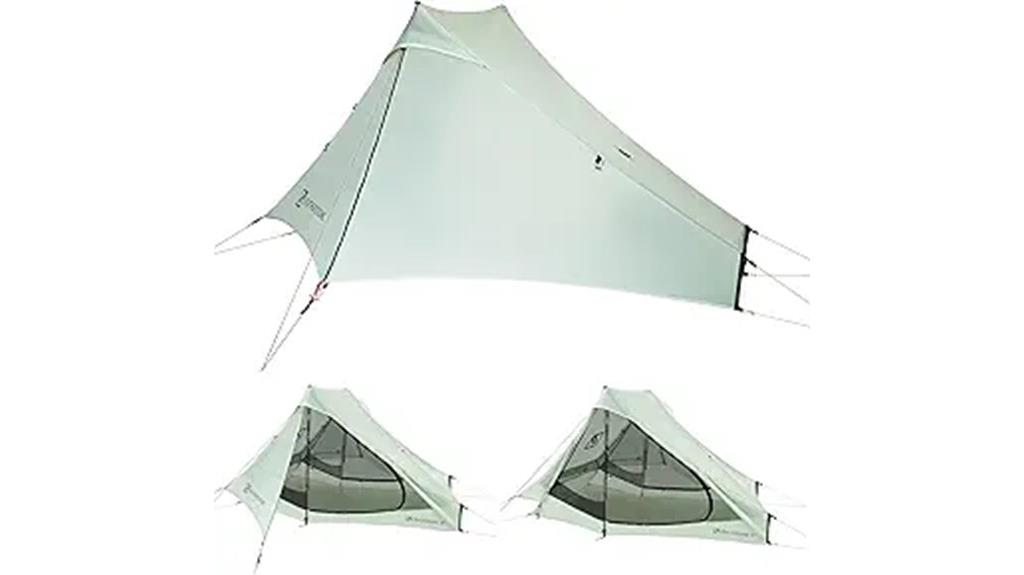
Ultralight backpackers seeking a balance between minimal weight and maximum livability will find their ideal shelter in the Featherstone Backbone Ultralight Tent. At 2 pounds 11 ounces trail weight, this trekking pole tent delivers 29.5 square feet of floor space across 85L x 50W x 45H inch dimensions. You’ll appreciate the dual-door, dual-vestibule design that maximizes gear storage and entry convenience. The single-wall construction uses sil-nylon fabric with seam-taped waterproofing and TPU zippers for weather protection. Setup requires only four corner stakes with your trekking poles. Wide mesh panels provide excellent ventilation while maintaining bug protection. Users rate it 4.3/5 stars, praising spaciousness and ease of setup for three-season backpacking adventures.
Best For: Ultralight backpackers and solo hikers who prioritize minimal pack weight while still wanting a spacious two-person tent with dual doors and vestibules for three-season camping.
Pros:
- Exceptional weight-to-space ratio at just 2 lbs 11 oz with 29.5 square feet of floor area and dual vestibules
- Simple setup using trekking poles with only four corner stakes required
- Excellent ventilation system with wide mesh panels that maintain bug protection
Cons:
- Single-wall construction may experience condensation issues in humid conditions
- Some users report the fabric can be see-through, reducing privacy
- Performance limitations in heavy rain conditions make it best suited for fair weather use
Naturehike Mongar 2 Person 3 Season Camping Tent
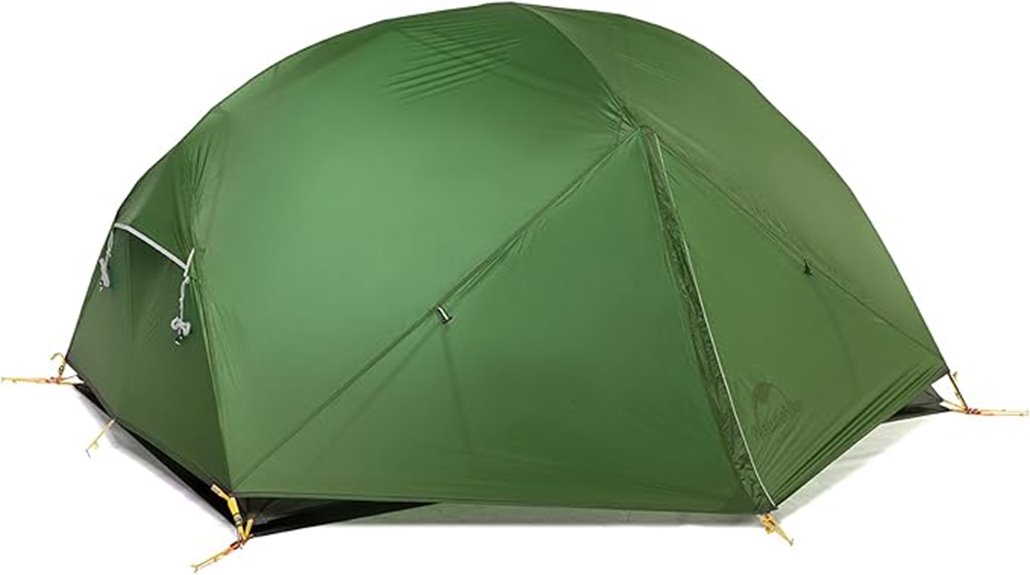
When you need a reliable shelter that balances weight and livability for extended trail adventures, the Naturehike Mongar 2 Person 3 Season Camping Tent delivers essential features without breaking your pack weight budget. At 5.3 pounds complete with groundsheet, it packs down to 19.7 x 5.9 inches for streamlined carrying.
The tent’s 82.7 x 53.2 x 41.3-inch dimensions provide over 30 square feet of sleeping space. You’ll appreciate the 210T polyester construction with 3000mm waterproof coating on both fly and floor. The 7001 aluminum alloy poles create a sturdy Y-frame structure that assembles in three minutes. Two doors and vestibules offer gear storage flexibility, while high-density B3 mesh maintains ventilation without sacrificing bug protection for reliable three-season performance.
Best For: Backpackers and hikers who need a lightweight, weather-resistant two-person tent with quick setup capabilities for three-season camping adventures.
Pros:
- Lightweight at 5.3 lbs with compact packing size makes it ideal for backpacking
- Dual vestibules and doors provide excellent gear storage and convenient entry/exit options
- Quick 3-minute setup with durable 7001 aluminum alloy Y-frame structure
Cons:
- Three-season rating limits use in harsh winter conditions
- 30 square feet of sleeping space may feel cramped for two larger adults
- 210T polyester fabric may be less durable than higher denier materials for long-term use
ALPS Mountaineering Lynx 1-Person Tent – Lightweight Backpacking Tent
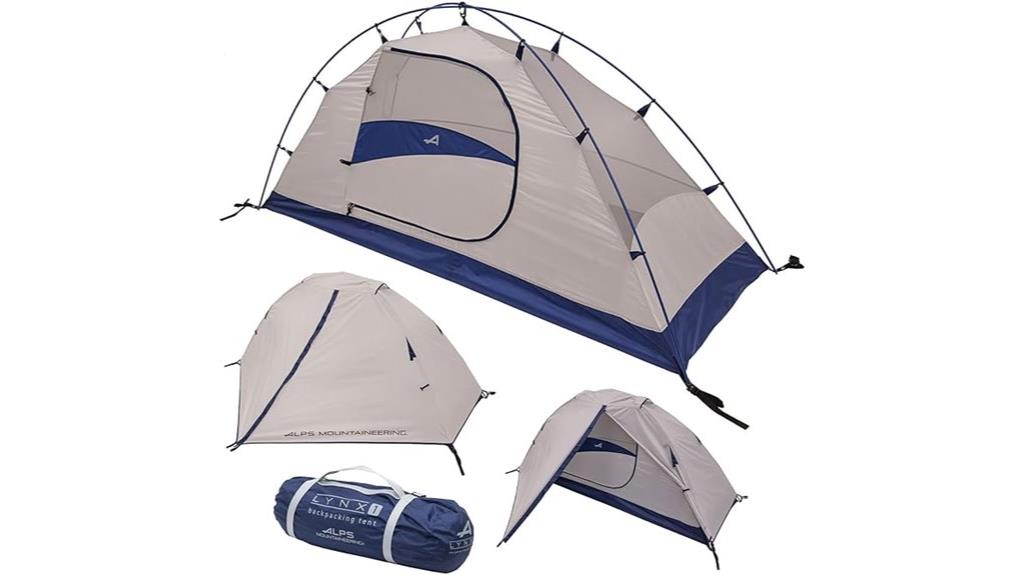
The ALPS Mountaineering Lynx 1-Person Tent targets entry-level backpackers who prioritize reliability and straightforward setup over ultralight performance. You’ll get a freestanding design with aluminum two-pole construction that assembles in under 15 minutes. The tent weighs 4 lbs. 1 oz. total, with a trail weight of 3.3 pounds.
Weather protection comes from a 1500mm rainfly and 2000mm floor coating with factory-sealed seams. Half-mesh walls provide ventilation, though airflow can be limited in hot conditions. You’ll have 20 square feet of floor space measuring 90L x 32W x 36H inches.
Storage includes one vestibule, mesh pockets, and a gear loft. Users report excellent durability and weather resistance, though you should replace the included stakes with MSR Groundhogs for better performance.
Best For: Entry-level backpackers and campers who prioritize reliability, easy setup, and durability over ultralight weight for 3-season adventures.
Pros:
- Freestanding design with simple two-pole aluminum construction that sets up in under 15 minutes
- Excellent weather protection with factory-sealed seams, 1500mm rainfly, and 2000mm floor coating
- Good storage options including vestibule, mesh pockets, and gear loft with lifetime warranty
Cons:
- At 4 lbs. 1 oz., heavier than ultralight alternatives for weight-conscious backpackers
- Limited airflow and ventilation in hot weather conditions despite half-mesh walls
- Included stakes are low quality and should be replaced with more durable options
Naturehike Village Camping Tent for 4/6/8 Person Family Camping
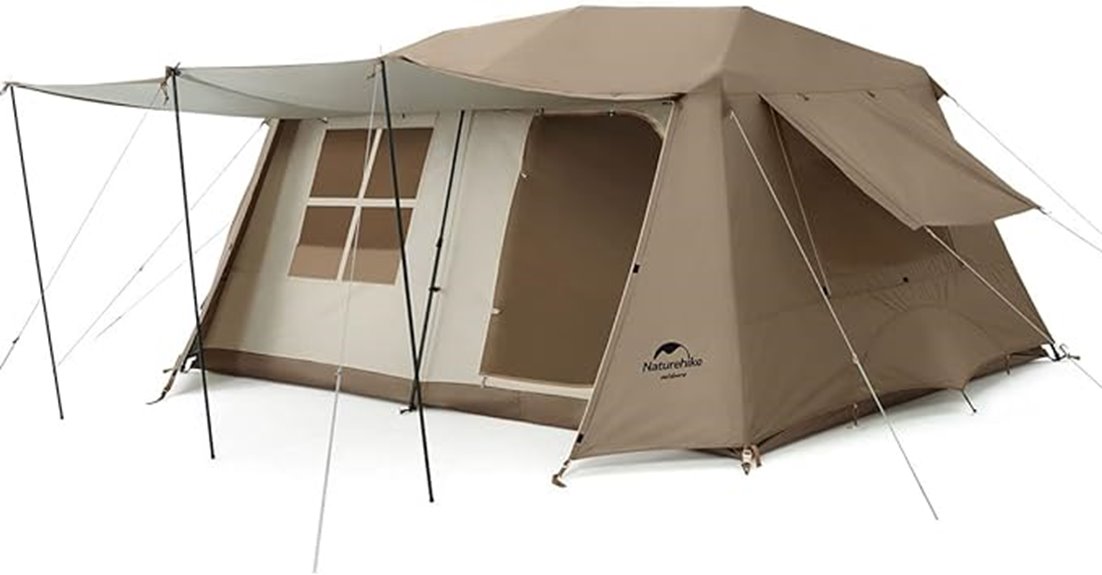
Large families seeking a versatile camping shelter that adapts to changing weather conditions will find the Naturehike Village Camping Tent exceptionally well-suited for their needs. This 4/6/8 person tent delivers 166.8 square feet of total space with a 70.8-inch ceiling height that allows comfortable standing room. The 150D oxford cloth construction features anti-UV blackout coating and 3000mm+ waterproof rating for reliable weather protection.
You’ll appreciate the four configuration modes: Full-Open, Enclosed, Awning, and Porch-Only setups that adapt to different scenarios. The pre-assembled frame system enables sub-60-second deployment using a clip-on attachment method. At 32.4 pounds, it’s heavier than ultralight options but remains manageable for car camping adventures.
Best For: Large families and groups who prioritize spacious, adaptable shelter with multiple configuration options for car camping and extended outdoor stays.
Pros:
- Exceptional versatility with four different setup modes (Full-Open, Enclosed, Awning, Porch-Only) to adapt to varying weather and activity needs
- Generous 166.8 square feet of space with 70.8-inch ceiling height allowing comfortable standing room and ample gear storage
- Superior weather protection featuring 150D oxford cloth with anti-UV blackout coating, 3000mm+ waterproof rating, and reinforced seams
Cons:
- At 32.4 pounds, significantly heavier than ultralight alternatives making it less suitable for backpacking or hiking trips
- Despite claims of 60-second setup, multiple components can make initial assembly time-consuming and potentially complex
- Lightweight stakes may require upgrading for better stability in challenging weather conditions
1 Person Tent for Camping Hiking (4 Season Windproof Waterproof)
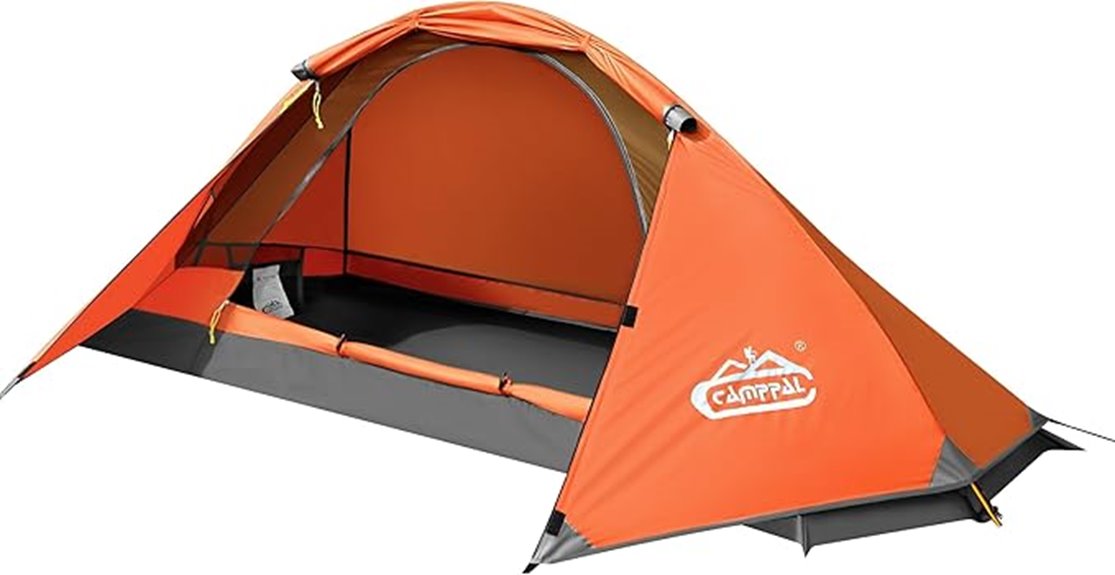
Solo adventurers who demand reliable shelter across all seasons will find this 1-person tent delivers exceptional performance through its robust 4-season construction and compact design. You’ll appreciate the 8.2-foot length that accommodates taller hikers while maintaining a lightweight 3.75-pound profile. The tent’s 3500-4000mm water resistance rating exceeds industry standards for extreme weather protection.
Setup takes just three minutes using a single ridge pole system. You’ll benefit from aluminum pole construction and anti-tear ripstop polyester fabric that withstands harsh winds. The vestibule area provides additional gear storage space while effective ventilation prevents condensation buildup. At 24.19 square feet of floor space, you’ll have adequate room for essential equipment and comfortable sleeping arrangements during extended thru-hiking expeditions.
Best For: Solo hikers, backpackers, and outdoor enthusiasts who need a lightweight, weatherproof shelter for year-round camping and extended wilderness expeditions.
Pros:
- Quick 3-minute setup with simple single ridge pole system, perfect for beginners and experienced campers alike
- Superior weather protection with 3500-4000mm water resistance and reinforced seams for all-season reliability
- Extended 8.2-foot length accommodates taller individuals while maintaining an ultralight 3.75-pound weight for backpacking
Cons:
- Limited interior space at only 2.95 feet wide and high, which may feel cramped for larger individuals or extended stays
- Single-person capacity restricts use for couples or those who prefer extra room for gear storage inside the tent
- No specific mention of ground clearance or floor protection features that may be needed for rough terrain camping
Naturehike Mongar 2 Person Lightweight 3 Season Backpacking Tent

Budget-conscious thru-hikers seeking dependable shelter without compromising essential features will find the Naturehike Mongar 2 Person tent delivers exceptional value at $99. You’ll carry just 5.29 pounds while gaining 30+ square feet of sleeping space and dual vestibules for gear storage. The tent’s 210T ripstop polyester construction with 20D nylon rainfly provides 3000mm water resistance ratings. Setup requires minimal effort thanks to the Y-frame design and 7001 aluminum poles. You’ll sleep comfortably at lengths up to 6.89 feet with 3.28 feet of headroom. B3 mesh panels and dual air vents guarantee adequate ventilation during challenging weather conditions.
Best For: Budget-conscious backpackers and thru-hikers who need a reliable, lightweight shelter that offers excellent value without sacrificing essential features like weather protection and gear storage.
Pros:
- Exceptional value at $99 with premium features typically found in more expensive tents
- Lightweight at 5.29 lbs with spacious 30+ square feet sleeping area and dual vestibules for gear storage
- Proven weather resistance with 3000mm water rating and successful real-world testing in winds up to 72 mph
Cons:
- Limited to 3-season use, not suitable for extreme winter conditions
- Maximum headroom of 3.28 feet may feel cramped for taller users
- At 2-person capacity, space may be tight for two adults with full gear
Altair One Ultralight Trekking Pole Backpacking Tent, 1 Person 3 Season Shelter

The Altair One Ultralight Trekking Pole Backpacking Tent delivers exceptional weight savings for hikers who prioritize every ounce in their pack. At just 2 pounds minimum trail weight, this single-person shelter uses your trekking pole as its structural support. You’ll get 86.6 inches of length and 47.24 inches of height in the pyramid design.
The 20D ripstop silnylon construction provides 3000mm waterproof protection with seam-sealed durability. You’ll appreciate the double-wall design that includes an inner mesh tent for ventilation and condensation management. Setup requires 6+ stakes for stability and takes about 20 minutes initially.
The vestibule offers gear storage space, though taller users may find interior dimensions restrictive. It’s earned 4.1 stars across reviews for rain protection and ultralight performance in mild three-season conditions.
Best For: Solo ultralight backpackers and hikers who prioritize weight savings and are comfortable with trekking pole setup complexity for 3-season mild weather conditions.
Pros:
- Exceptionally lightweight at just 2 pounds with generous length and height dimensions
- Effective waterproof protection with 3000mm rating and seam-sealed construction
- Large vestibule provides ample gear storage space
Cons:
- Condensation issues and interior space may be restrictive for taller users
- Requires considerable tweaking and 6+ stakes for proper setup and stability
- Not suitable for extreme weather conditions without additional gear
Factors to Consider When Choosing Thru Hike Tents
When I’m selecting a thru-hike tent, I focus on five critical factors that’ll determine whether my shelter enhances or hinders my journey. Weight and packability matter most since every ounce counts over thousands of miles, but I can’t sacrifice weather resistance ratings that protect against wind speeds above 35 mph and heavy precipitation. Setup efficiency, durable materials like 20D ripstop nylon, and interior dimensions that accommodate my gear without cramping become equally important for long-distance success.
Weight and Packability
Every ounce you carry on a thru-hike compounds over thousands of miles, making weight your primary consideration when selecting a tent. I recommend targeting the 2-5 pound range for ideal balance between portability and functionality. Ultralight options under 3 pounds maximize efficiency but often compromise durability and interior space.
Packability matters equally. Your tent should compress into a 16-24 inch bundle that fits seamlessly in your pack’s main compartment. High-grade polyester and nylon fabrics paired with aluminum poles deliver the best weight-to-strength ratios.
Construction materials directly determine overall weight. Quick-setup designs minimize camp time, letting you cover more trail efficiently. Don’t chase the lightest option blindly—evaluate your specific hiking needs against weight savings to find your perfect balance.
Weather Resistance Rating
Weight considerations matter little if your shelter fails during a storm. I prioritize tents with waterproof ratings of 3000mm or higher for reliable heavy rain protection. The measurement indicates millimeters of water pressure the fabric resists before leaking occurs.
However, fabric rating isn’t everything. I examine seam taping quality and zipper waterproofing—these weak points cause failures regardless of fabric performance. Poor sealing negates even 5000mm-rated materials.
Breathability matters equally. High-quality fabrics balance water resistance with airflow, reducing interior condensation that’ll soak your gear anyway. I look for design features enhancing weather performance: full rainflies, bathtub-style floors, and strategic ventilation systems. These elements work together, creating reliable moisture barriers while maintaining interior comfort during extended storms.
Setup Speed Efficiency
Three minutes can mean the difference between dry gear and a soaked sleeping bag when storm clouds roll in during your evening setup. I prioritize tents with assembly times under five minutes for thru-hiking efficiency.
Freestanding designs eliminate the need for extensive staking, allowing setup on rocky terrain or sand. You’ll achieve faster pitching with color-coded poles and clips that guide assembly intuitively. Trekking pole tents reduce pack weight but require proper technique—practice your setup sequence before hitting the trail.
Setup times vary dramatically: simple A-frame shelters assemble in under two minutes, while complex multi-pole designs may require fifteen minutes. I recommend practicing your chosen tent’s setup at least five times at home. Muscle memory translates to confident assembly during challenging weather conditions when speed becomes critical for gear protection.
Durability and Materials
Quick setup won’t matter if your tent falls apart during the first week on trail. I prioritize high-grade materials like 210T polyester or nylon for superior durability and waterproofing. These fabrics offer water penetration ratings up to 5000 mm, ensuring you stay dry in severe weather.
Frame construction directly impacts longevity. Aluminum poles and carbon structural steel provide lightweight yet robust support systems that withstand harsh conditions. I look for seam-taped and double-stitched construction to prevent leaks during intensive use.
UV protection extends fabric lifespan considerably. Anti-UV coatings block harmful rays that degrade tent materials over time. Material choice creates a critical balance between weight and resilience—ultralight options sacrifice some durability for reduced pack weight. This trade-off requires careful consideration based on your specific hiking demands.
Interior Space Dimensions
While durability forms the foundation of tent selection, interior space dimensions determine your daily comfort throughout months of trail life. I recommend prioritizing tents with 20 to 30 square feet for two-person configurations. This provides adequate room for gear organization and movement.
Height matters considerably. Look for minimum 36-inch peak heights that allow comfortable sitting without feeling cramped. Solo hikers should target 30-inch widths to accommodate standard sleeping pads with gear storage space.
Double-layer designs typically offer superior spatial layouts. They accommodate full-sized pads side by side for multi-person use. Length becomes critical for taller individuals—seek tents exceeding 86 inches for ideal comfort. These dimensions prevent foot contact with tent walls and create livable space for extended wilderness periods.
Ventilation System Design
Because condensation can transform a comfortable shelter into a miserable experience, ventilation system design ranks among the most critical factors in thru-hiking tent selection. I prioritize tents with strategically placed mesh panels and large vents that maximize airflow while blocking insects. Dual-door configurations provide superior air circulation compared to single-entry designs, allowing me to customize ventilation based on wind direction and weather conditions.
Adjustable vent openings prove essential during temperature fluctuations. I look for tents featuring roof vents positioned opposite ground-level openings to create effective cross-ventilation. This setup prevents moisture accumulation during rainy conditions while maintaining interior comfort during hot weather. Proper vent placement greatly improves temperature regulation, especially during extended backcountry stays where tent performance directly impacts sleep quality and overall hiking experience.
Pole Configuration Options
The pole configuration you select fundamentally determines your tent’s weight, setup complexity, and structural performance on the trail. Freestanding designs use aluminum poles that create independent structures without requiring stakes. These configurations typically weigh 8-12 ounces more than ultralight alternatives but offer superior setup versatility on rocky terrain.
Trekking pole tents eliminate dedicated poles entirely, using your hiking poles for support. This approach can save 6-10 ounces from your pack weight while maintaining structural integrity. However, you’ll sacrifice your trekking poles during camp setup.
Double-wall tents employ pole configurations that separate inner and outer layers, enhancing weather protection through improved airflow. Cross-pole arrangements provide maximum wind resistance, distributing loads across multiple points. Simpler single-pole designs reduce weight but compromise headroom and interior volume considerably.
Price Performance Value
Smart tent purchasing requires analyzing cost against measurable performance metrics rather than selecting the cheapest or most expensive option available. I evaluate tents by comparing their price against essential specifications like waterproof ratings above 3000mm and weight under 5 pounds.
Budget-friendly models often deliver comparable features to premium options. You’ll find excellent value in tents that balance affordability with proven durability and positive customer feedback. I prioritize reliable construction materials and verified waterproof performance over brand prestige.
Customer satisfaction ratings reveal real-world performance data that manufacturer specifications can’t capture. A tent’s long-term value emerges through consistent weather protection and structural integrity across multiple hiking seasons. The best price-performance combinations offer essential features without unnecessary premium costs that don’t enhance trail functionality.
Frequently Asked Questions
How Do I Properly Maintain and Clean My Thru-Hiking Tent?
I’ll clean my tent after each trip using lukewarm water and mild soap. I’ll avoid machine washing since it damages waterproof coatings. I’ll hand-wash the rainfly and body separately, then air-dry completely before storage. I’ll inspect seams for wear and reapply seam sealer annually. I’ll store it loosely packed in a breathable sack, not the stuff sack, to prevent mildew and maintain loft.
What’s the Average Lifespan of a Lightweight Backpacking Tent?
I’ve seen lightweight backpacking tents last 3-7 years with proper care. Your tent’s lifespan depends on usage frequency, weather exposure, and maintenance quality. Budget models typically last 50-100 nights before showing wear. Premium tents handle 150-300 nights effectively. Ultralight fabrics sacrifice durability for weight savings. UV damage, abrasion, and seam failure cause most premature failures. I recommend replacing tents when waterproofing fails consistently or structural integrity becomes compromised.
Can I Use Trekking Pole Tents Without Actual Trekking Poles?
You can’t properly pitch most trekking pole tents without actual trekking poles. These shelters rely on poles as primary structural support, typically requiring two poles at specific heights. I’ve seen hikers use substitute supports like sturdy branches, but this creates stability issues and potential damage. Some manufacturers offer optional tent pole sets for their trekking pole models, though this adds significant weight and defeats the ultralight purpose.
How Do I Repair Small Tears in My Tent While on Trail?
I carry Tenacious Tape or similar fabric patches for instant repairs. Clean the torn area completely, then apply the patch with firm pressure for 30 seconds. The adhesive bonds permanently without heat. For larger tears exceeding 2 inches, I’ll sew the edges first using dental floss, then cover with tape. Seam Grip works for waterproofing around repairs but requires 8-hour cure time.
What’s the Difference Between 3-Season and 4-Season Thru-Hiking Tents?
I’ll explain the key differences between 3-season and 4-season thru-hiking tents. Three-season tents handle spring, summer, and fall conditions with lighter fabrics and more ventilation. They typically weigh 2-4 pounds and use 20D-40D nylon. Four-season tents withstand winter conditions using heavier 70D fabrics, stronger poles, and reduced ventilation. They weigh 4-7 pounds but offer superior wind resistance and snow load capacity for year-round hiking.
On a final note
I’ve evaluated these ten tents across weight, durability, and weather resistance metrics. Your choice depends on specific trail conditions and capacity needs. Single-person ultralight models like the Altair One deliver maximum weight savings at 1.5 pounds. Two-person options like the Naturehike Mongar balance space and portability. Four-person tents suit group hiking but increase pack weight considerably. Consider your hiking style, expected weather conditions, and weight tolerance when making your final selection.

